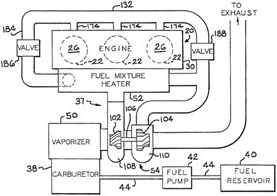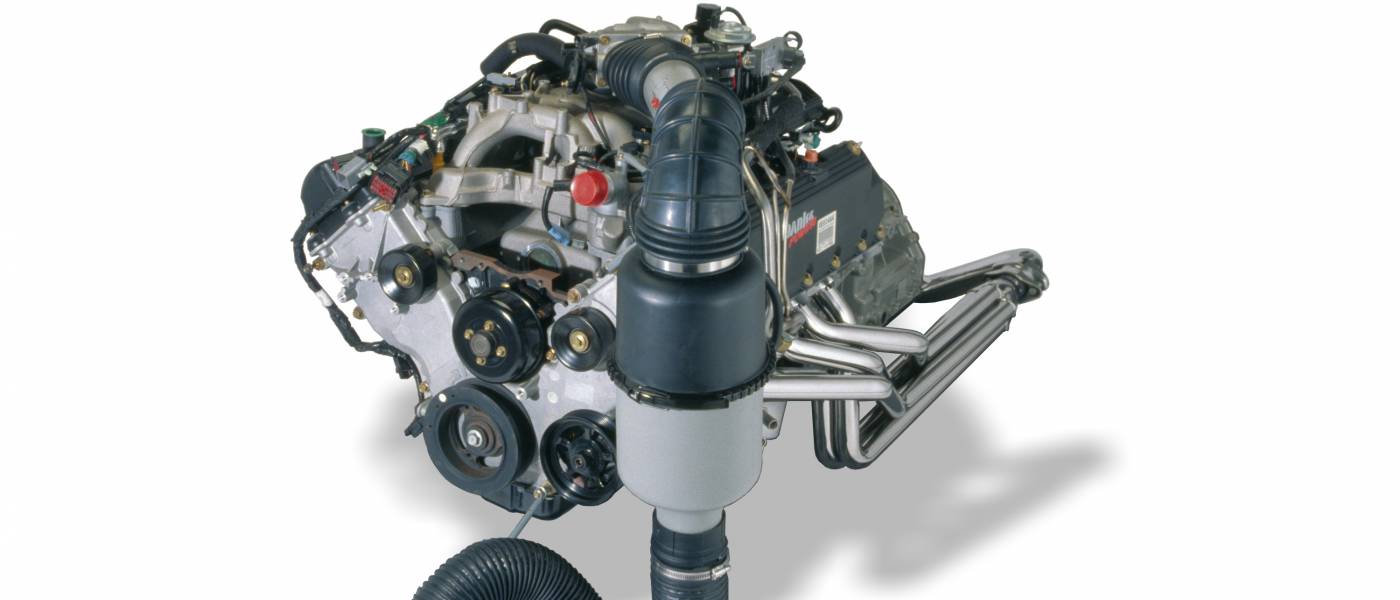Cool Air Equals Power
Cool air is good for making power, but could hot air be even better?
|
The Banks Super Scoop, as shown on this Ford V-10 gasoline engine, provides both cool air and a mild ram-air affect. The Super Scoop also incorporates a water drain to separate any rainwater from the airflow entering the scoop. |
Most people know that engines make more power when the inlet air is cooler. Let’s take a look at why this is true – at least in most applications. We’ll also tell you right up front that this article might leave you with more questions than answers. Then again, you might be the one that provides the additional answers and takes the world to the next generation of internal combustion engines.
To understand what goes on during both the intake cycle and the power cycle when inlet air temperature is reduced, we need to consider both normally-aspirated and supercharged gasoline engines, as well as turbocharged diesels. We’ll also limit this discussion to four-cycle engines.
Before we go any further, let’s define a couple of terms. For this article, we’ll say that supercharging is anything that increases the amount of oxygen available in the cylinder to support combustion of fuel above what could be expected from cylinder filling due to atmospheric pressure only. We’ll assume atmospheric pressure at sea level to be 14.7 PSI and that “normal” air contains approximately 21 percent oxygen. We’ll also exclude oxygen-bearing fuels, such as nitromethane, as a form of supercharging. This means that any form of mechanical compressor that pumps more air into an engine, such a belt- or gear-driven “supercharger”, or an exhaust- or turbine-driven “turbocharger” is included, as well as the injection of nitrous oxide, or even oxygen itself.
Gale Banks has a favorite saying, “It’s all about airflow.” Airflow helps engines make power in many ways, as explained in other articles on this site, but it is also true that the more air you can flow through an engine, the more oxygen that will be available for burning fuel. More oxygen means more fuel can be burned, and that means more power. Maybe his saying should be refined for this article to be “It’s all about oxygen content.” This is most evident when dealing with an ordinary normally-aspirated gasoline engine. Many hot rodding tricks relate to getting more air(read oxygen) into the cylinder. Whether it’s by installing a less restrictive fuel injection system or carburetor, a freer flowing intake manifold, porting the cylinder head(s), increasing camshaft lift or duration, the purpose is still the same – get more oxygen into the cylinder. Now in all fairness, the hot rodder is looking at getting maximum oxygen into the cylinder at wide open throttle for peak power (to beat the other guy). This is partly why nitrous oxide (an oxygen-rich gas) injection is so effective. Nitrous oxide effectively increases the percentage of oxygen in the working fluid (which becomes a mixture of air, nitrous oxide, and fuel) above the 21 percent oxygen in air alone. That means more fuel can be mixed into the working fluid too for greater combustion heat to expand the working fluid and increase pressure in the cylinder. Additionally, when the compressed nitrous oxide, which is stored in its pressurized container as a liquid, is injected, it depressurizes and changes state from a liquid to gas, cooling the working fluid for an accompanying density increase. Of course, it would take an incredible amount of nitrous oxide to be able to use it at all times, so as you would expect, nitrous oxide injection is only used on demand at wide open throttle. But what if we could get more oxygen into the engine at all throttle positions all the time? Then what happens?
In another article on this site, “Airflow – the Secret to Making Power”, we explain that the air throttle on a gasoline engine controls the density of the intake charge that enters the cylinder. We also explain how superchargers and turbochargers increase the density under boost conditions. In some regards, we can look at density as the amount of oxygen crammed into a given volume of air (the working fluid). Increased density means the molecules in the air are closer together in the same space – more air mass (and oxygen) in the same space. Here’s where things can get a little muddy. We have to consider increased air density in both unconfined and confined spaces. Let’s look at an unconfined space, such as the atmosphere, because that’s the world of the normally-aspirated engine. Two things affect air density in the atmosphere – pressure and temperature. As atmospheric pressure goes up, indicated by higher barometric pressure on a barometer, the density increases if the temperature stays the same. In other words, at any given temperature, if the barometric pressure rises, so does the air density. By the same token, as temperature goes down, the density increases if the atmospheric pressure stays the same. Atmospheric air density is very important to normally aspirated engines. Obviously, you can’t do much to increase the atmospheric air pressure in regard to a normally-aspirated engine, but you can enhance it slightly with some form of ram air taken either from the front of the vehicle or from a dynamically high pressure area, such as the base of the windshield. More importantly, in most cases you can do something about the temperature of the inlet air. The object is to get the coolest air possible to the engine’s intake system. Many engines induct air that has passed through the radiator or over other warm areas of the engine, significantly heating the air and reducing its density. By relocating the air intakes to duct outside air that hasn’t been warmed into the engine, density is significantly increased. For example, it is not uncommon for air to increase up to 50º F. passing through the radiator and air conditioning condenser on a late model vehicle. The general rule of thumb is that for every 10º of temperature drop, the density (and oxygen content) increases 1 percent. It’s actually more like 1.8 percent. Similarly, power increases by an equal amount. So, in this example, if you can intake air that hasn’t been heated, you can gain as much as 5 to 9 percent more power. Happily, the best places to collect cool air are the same places that work for ram air, so you can get the density gains from both pressure and temperature using the same intake ducting.
To get back to our earlier question of what happens when we have cooler, or higher density, air at all throttle positions, it means that the engine is capable of producing given amounts of power at lesser throttle openings. This generally equates to better fuel economy. It also means the engine has greater power potential for accelerating or climbing grades. Cooler intake air also suppresses detonation since the working fluid doesn’t reach as high a temperature on the compression stroke – again, a plus for accelerating or climbing grades.
Both gasoline and diesel engines that use superchargers and turbochargers face their own unique problems with intake air temperature. Superchargers and turbochargers significantly heat the intake air as they compress it to create boost. The higher boost pressure increases the air density, but the increased temperature of the air can largely offset this density gain. In this case, we’re talking about the affects of pressure and temperature in a confined space, the intake system. Consequently, it is desirable to cool the compressed air before it enters the engine. In most cases, especially where boost levels exceed 7 PSI, cooling the compressed air with a charge air cooler, often called an intercooler, increases the air density more than any density losses that occur due to the accompanying pressure drop due to cooling or flow restrictions through an intercooler. In other words, intercooling results in a net density increase for the air entering the cylinder.
Intercooling also provides other benefits. For supercharged or turbocharged gasoline engines, reducing the intake air temperature suppresses detonation, just as it does for normally-aspirated gasoline engines. For diesel engines, intercooling not only increases charge density, it also results in lower exhaust gas temperature. Excessive exhaust gas temperature, above 1300º cannot be sustained in a diesel without eventual engine and/or turbocharger failure. Lowering intake temperature results in an almost equal reduction in exhaust temperature. For example, the air exiting the turbocharger on the Banks Sidewinder pickup was approximately 500º F. under full power. Dual air-to-water marine intercoolers, connected to a reservoir of ice water, were then used to reduce the air temperature to 100º F. before it entered the engine. With the intercooling, exhaust temperatures remained manageable for the duration of the Bonneville World Speed Record runs. Without intercooling, the exhaust temps would have been in the 1800º-1900º F. range.
The final conclusion is that regardless of whether an engine is normally aspirated or supercharged, gas or diesel, the cooler the intake air, the better. Usually.

Now comes the really interesting part of this article that raises all the questions. Twenty years ago, the late, great racing mechanic and inventor Henry “Smokey” Yunick left the automotive engineers shaking their heads when he invented and patented his hot vapor engine. Based on the familiar four-cycle piston engine concept, instead of cooling the intake air to improve efficiency, he used coolant heat and exhaust waste heat to significantly warm the intake air. The purpose was to fully vaporize the fuel and to make the intake air expand in the intake system to generate positive pressure, like a supercharger. A small turbocharger was used as a “mixer” and as a check valve to prevent the expanding intake air from backflowing out of the intake system. With the heated, pressurized, homogenous mixture, the engine ran at air/fuel ratios considered impossibly lean, such as 22:1, on pump gasoline. The hot vapor engine made incredible power and was highly efficient, responsive, surprisingly emissions clean, and delivered fuel economy of 45-50 MPG in a compact car, and it did it all without computers, smog pumps or catalytic converters. Although initially denounced by the automotive world as a hoax, several prominent SAE engineers later published papers validating Smokey’s theories and design. It was no hoax to Smokey. He considered it his greatest achievement. However, the automotive giants had their own designs for increasing fuel economy and controlling emissions, and Smokey’s simple and cost-efficient engine package was ignored. Today, Smokey’s designs are buried somewhere in the U.S. Patent Office (www.uspto.gov, patent numbers: 4,503,833; 4,592,329; 4,637,365; 4,862,859) awaiting someone to take this technology to the next level. So just when you think you know the rules of how things work, somebody comes along and breaks the rules. It’s only fitting that it was Smokey Yunick.

